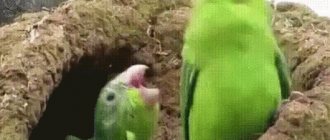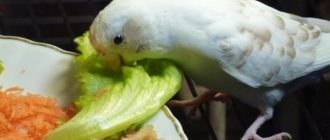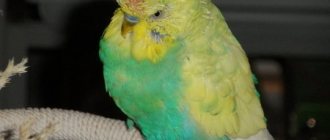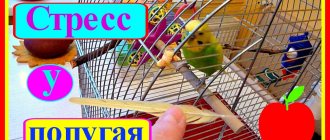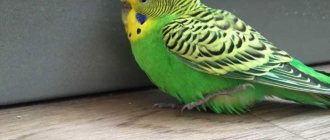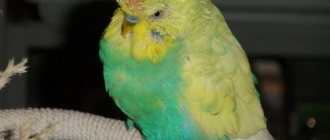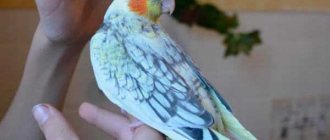Kakadu is translated from Malay as “biters”. This name for this large bird was not chosen by chance - its 10-centimeter beak can easily bite a human finger. In other breeds, the beak is not so large, but in any case it can pose a threat to the owner of the feathered friend. Let's find out why parrots love to bite and how to wean them from this habit.
How to stop a parrot from biting
Aggression in response to a bird bite is a big mistake. Without finding out and understanding the reason for your feathered friend's behavior, you destroy trust and mutual understanding between you.
Photo: Zeetz Jones
Birds have a different way of thinking; their beak is intended not only for feeding, but also for communication, expressing their feelings and exploring the world. In their understanding, biting, grabbing and pinching is a demonstration of their love for you, and your inadequate (in their understanding) reaction offends and alienates the bird.
As stated above, you need to distract, redirect the parrot’s attention in every possible way to other objects, toys or food. You can also express your dissatisfaction by stopping playing with the parrot; the bird will quickly understand that if it bites, it will have to have fun alone, without company. You can also express your dissatisfaction by stopping playing with the parrot; the bird will quickly understand that if it bites, it will have to have fun alone, without company
You can also express your dissatisfaction by stopping playing with the parrot; the bird will quickly understand that if it bites, it will have to have fun alone, without company.
You can feign offense and leave the room for a while; the parrot must understand that you do not like this behavior. Choose a word (you can’t, ugh, why, no, it hurts) that will mean that you are upset by the parrot’s behavior and that you don’t need to do this anymore.
Sometimes the cause of parrot bites may be an object that instills fear in them. This could be the sounds of a washing machine, coffee grinder or vacuum cleaner, or a new plant, piece of clothing or pet.
When the bird understands what they want from it, and the owner knows how the parrot will behave, incidents of bites are reduced to zero.
Photo: Dave Stevenson
You need to train a parrot when the bird is ready to communicate. Your voice should be even and calm despite the noise and restlessness of the “student”. Always maintain your composure and do not raise your voice, parrots love noise and will perceive your scream as encouragement and a signal to continue in the same spirit.
Since parrots respond to praise and recognize facial expressions, use this in your training. Hierarchy is important to the bird - who is the boss in the house. If you allow it to sit on your shoulder and head, you are not only exposing yourself to being bitten, but you are also "lowering" yourself in the parrot's eyes. When he begins to feel like he is the main one in the house, it is very difficult to control such a bird.
Raising a parrot is a bit like raising a child
Here, too, it is important to maintain composure and prudence. You should always think things through before changing your behavior with your feathered friend. Photo: Mark Dumont
Photo: Mark Dumont
Parrots are smart and quick-witted birds that are good at connecting actions with words. They will quickly learn that biting is not good and it makes you sad.
React to a bite immediately, but not by screaming or clicking the beak. Suffice it to say strictly that you cannot look angrily at the bird and take it to the cage. There is no point in making a scene - this is a useless exercise that provokes the bird into further painful tricks.
How to eliminate aggression in a bird?
Before you begin raising your overly vicious pet, you should first find out the reason for this behavior, and then begin to eliminate it.
There are different ways to help calm your bird. Let's look at some of them.
- Training. It is most effective to start training your pet before he starts biting. Therefore, after purchasing a bird, do not delay it and, as quickly as possible, teach it to calmly climb down from the perch and sit on your finger and, conversely, to climb from your finger to the perch. If the bird has long acquired a taste for it and behaves quite viciously towards you, then training should be carried out in an unfamiliar environment for it. For example, ask your relatives or neighbors. After all, in someone else’s walls she will not be brave and will not dare to offend the only person she knows.
- Verbal praise. The parrot can react to your facial expressions and words, so if he has done something correctly, be sure to praise him. Talk to the feathered one in a completely calm tone. Do not yell at him under any circumstances, because any raising of your voice may remind him of the calls of birds, which he likes. And he will begin to do everything to make it happen again.
- Dominant position. Never allow a sufficiently aggressive bird to land on your head. Firstly, she may peck you painfully on the ear, and secondly, such a bird will feel its advantage over you.
- Disapproving gestures. Never ignore your pet's bite. If a bird sits on your finger and bites, be sure to jerk your hand so that it understands that such behavior is simply unacceptable. However, the parrot should not fall, as it may get injured. After this, you should put the parrot in a cage, let him rest and think about his behavior.
- Avoid shock situations. Do everything to create a favorable environment in your home. Do not use a vacuum cleaner near the cage, and also do not have other pets in the apartment that will dream of grabbing it.
- Do not invade the territory of birds during the breeding season. Let the female and male feel completely safe and not worry about their offspring once again.
And remember, if the cockatiel parrot has become aggressive, then do not let the situation take its course, perhaps he is just sick and needs your help.
Natural features
In their natural habitat, birds constantly explore the world around them, in search of food and favorable living conditions. And they can “feel” an object only with the help of their beak and tongue
But it is important to remember that in this case attempts to chew on the bars of the cage will be infrequent and the periodic addition of new, interesting, safe toys will solve this issue
The instincts are to grind down the beak, because it does not stop growing throughout the pet’s life. The parrot should always have freely available objects that help with this: pieces of wood or tree bark, pieces of limestone or sandstone. If the bird still prefers rods, then you need to take care of the safety of this material; stainless steel without a color coating is best. This will protect him from eating harmful substances. If the beak grows excessively, only veterinary specialists can help.
Beak diseases
The most common beak disease is overgrowth. However, this is not an independent disease, but a symptom complex associated with a large number of pathologies. The causes of beak overgrowth or curvature can be infectious diseases, for example: circovirus infection, cryptococcosis, mycobacteriosis, aspergillosis. Behavioral disorders caused by both improper maintenance (example: a cramped cage provokes constant gnawing of the cage bars and this leads to one-sided deformation or chips on the beak), and improper feeding of parrot chicks, which leads to mental disorders. Also, with the wrong method of feeding chicks of large and medium-sized parrots (jacots, macaws, amazons, cockatoos, eclectus), deformation of the jaw bones occurs, the beak is shifted to the side. If this problem is not solved in time, then the bird will remain with a crooked beak for the rest of its life, which in the future leads to problems with the spine and all the ensuing complications.
In budgerigars, the most common cause of beak deformation is scabies (scabies are described below in the “parasites” section) and chronic staphylococcal infection. With staphylococcosis of budgerigars, the beak remains shiny in appearance, but begins to grow very quickly, and dark longitudinal stripes or spots appear at the tip of the beak. The same spots may appear on the tips of the claws.
Therefore, if you notice that the parrot's beak is growing too quickly or is bent, it is not enough to simply sharpen or trim it, a full examination of the bird is required.
Causes
Among the reasons why a parrot chews under its wing are the following factors:
- Lack of nutrients and vitamins in the body. This phenomenon may be due to calcium deficiency. In this case, the bird begins to peck its wings and inflict wounds on itself. It is recommended to maintain a balance in food and regularly include vitamin complexes in your diet. The best option to prevent nutritional deficiencies is to use a vitamin mixture;
- The presence of parasites on the parrot’s body, which cause discomfort and force it to constantly scratch and peck at the body. Among the frequent parasites actively living in the plumage and under the skin are mites and feather eaters;
- The parrot chews under its wing because it is bored. This family creates a mate for life, so if you lose your half for various reasons, the pet can become very bored and get sick. Quite often, when alone, feathers are plucked, wings are pecked until there is blood. In general, the behavior of the bird changes greatly and becomes depressed. This condition can also occur as a result of a change in owner. This is especially true for large species of the family that live for a long time with one person;
- Pet habit. Strange behavior can be a manifestation of character in certain situations. Perhaps the pecking is due to demands for attention.
Diagnosis of the disease
It is almost impossible to independently detect the presence of a mite on a bird’s body. After all, the size of the largest parasite is less than half a millimeter. The disease is scary because such a microscopic infection can kill an adult and healthy parrot. Ticks live in the layers of the epidermis, gnawing out entire tunnels on the skin of the bird, while releasing toxins, poisoning it.
After infection, signs of the disease do not always appear immediately. The incubation period can last more than three months. To finally make sure that the bird is sick with knemidocoptosis, and to prescribe the correct treatment, it is necessary to pinch off a piece of skin from the affected area for examination under a microscope.
Why does a parrot make unpleasant noises?
Depending on the type of parrot, there may be different reasons for screaming. Their volume and intensity also vary.
Runs around the cage and screams
A bird may do this for the following reasons:
wild and untamed individual; stress, anxiety, fear, feeling of danger; disease or parasites; change in living conditions or family composition; lack of food or water; an attempt to attract attention.
In addition, parrots do not like to be left alone and can react with loud sounds when their owner leaves the house.
Therefore, it is better to have several birds at once, and if there is only one pet, you should gradually accustom it to the fact that for some time it will be deprived of company. Many birds respond well if they are left with a radio turned on quietly.
Yells in the morning
The cry of birds in the morning is a completely natural phenomenon. The fact is that their greatest activity occurs in the early morning hours and before sunset. Therefore, the biological rhythms of parrots living at home completely coincide with the rhythms of their wild relatives.
The exception is situations when the length of daylight hours is artificially regulated. For example, if you put a blanket over a parrot's cage, then most likely there will be no usual morning cry.
Screams at night
If the parrot has recently appeared in the house and is not tamed, then any sounds or movements may frighten it. This is the headlights of a passing car, sounds outside the window, the cry of a night bird, the noise of a fan or the movement of curtains. The result of this is a strong cry, with which the bird expresses its fear and tries to scare away a potential enemy. During this period, she may begin to rush around the cage, risking damage to feathers or wings. If this happens, you need to immediately turn on the light, calmly and affectionately talk to your pet, and offer him fresh water. It is also necessary to remove damaged feathers and treat these areas with a solution of hydrogen peroxide.
And when planning the cage environment, perches and toys should be positioned in such a way as to reduce the risk of injury in the future.
We teach you to sit on your finger
The parrot must learn to respond painlessly to hands:
- Behave calmly and do not make sudden movements when trying to train your parrot to sit on your finger.
- Speak peacefully and quietly.
- Try to give your pet the opportunity to get used to your hands - conduct classes daily.
- When you try to bring your finger closer to the bird, lightly stroke the chest and legs of your feathered friend.
It is best to tame a parrot during the day, and not in the evening. Don’t rush into hand training – consider the bird’s mood.
Riot in a cage
If you see that your pet is huddling towards the exit, or hanging upside down on the bars of the cage, this is a request to let him out for a walk. The parrot can also shift from paw to paw and quickly run from side to side, showing impatience to quickly be free. If you do not pay attention, the request will soon turn into an insistent and indignant demand: the bird will begin to emit heartbreaking screams.
If a parrot rummages aimlessly in a feeder and throws out food, this is also a kind of demonstration of “freedom for parrots!” This behavior is often typical for young chicks when they are “torn off” from their parents and placed in another cage. If your parrot behaves like this, then most likely it was sold very young, and it was not fully cage trained
Over time, of course, he will adapt - but he really needs your friendship and attention
Parrots are very interesting and mischievous creatures and watching them brings a lot of pleasure, lifts the mood and makes anyone happy.
Often, some of the habits of our feathered friends lead to bewilderment and there is a desire to understand the reason for such movements, poses and strange sounds.
By carefully studying your bird, you can come to the conclusion that the behavior of parrots is determined by certain factors: biological (puberty, instincts) and external (lifestyle, nutrition and living conditions of the bird).
Budgerigars have a changeable mood: they were just having fun and screaming, and now they are sitting ruffled and grumbling.
Photo: garden beth
It is very important to understand when a bird’s behavior is normal and when to be alarmed. In the first days at home, tame budgies quickly get comfortable and begin to energetically explore everything with interest.
In the first days at home, tame budgies quickly get comfortable and begin to energetically explore everything with interest.
Why does the bird bite?
You've probably noticed that the budgerigar's beak is very powerful. He easily bites small grains with it and removes the husks from them. The bites of the wavy are quite painful, because due to the structure of the beak, it does not pinch the skin, but literally tears it out, which can lead to an unpleasant injury. Why do budgies bite?
In their natural habitat, parrots do not tend to bite at all. They use their beak only for its intended purpose, biting into berries, grains and other food products. Parrots also need a beak in order to calmly move from branch to branch, grabbing onto them and pulling up their body.
When conflict situations arise between their brothers, the beak is also not used as defense or attack. As a rule, budgerigars use a loud voice and menacing flapping of their wings to do this.
Single budgerigars raised in captivity may not quite understand why their owner walks around with a dissatisfied face and gets angry when he pecks his hands. Parrots, as a rule, learn from each other and, as they adapt to new living conditions, they understand what can be done and why some things cannot be done.
So why do budgies bite?
Fear
In their natural habitat, parrots always fly away when they notice a danger to their lives, but in a cage that limits their movement, they have nowhere to go, and a large hand can look quite intimidating for such a small bird.
It is guided by fear that a budgie can bite. And having noticed that such defense tactics work well, the feathered pet may well learn to use its beak as a weapon to scare off the enemy (in our case, this is the hand of the bird’s owner) and avoid danger.
I would like to note that budgies are far from stupid birds, and can even learn to manipulate their owner. The bird's owner wants to play with it, but it wants to eat and fly around its house - as a result, the feathered friend bites to defend its position.
You can stop your bird from biting. And we will tell you how to do this a little later.
Manifestation of character
Most birds, feeling that they are allowed to do almost everything without being punished for every misdeed, take a dominant position and place themselves higher than their owners.
Hence the aggressive behavior and protests in the form of bites.
Mating season
The mating season brings with it some changes in the character of the budgerigar, especially of the stronger sex, because the budgerigar has a need to find a mate, start a family, and organize the defense of its territory and future offspring in various ways.
What to do if a parrot bites? How to stop a parrot from biting?
How to stop a parrot from screaming
Before you try to wean your pet from screaming, you should determine its cause. To do this, it is worth observing him for some time and noting the situations in which he begins to scream.
It is best to record this data in table form.
- Date and time.
- Condition for a cry to occur.
- The nature and duration of the cry.
In other cases, it is necessary to analyze the data obtained.
Morning screaming is normal, but if for some reason it is undesirable, you can simply reduce the bird's daylight hours by throwing a cloth over the cage. Then the parrot will be calm until you remove it.
The same measure will help get rid of night screaming. It will also allow you to regulate the bird’s sleep pattern so that its duration is 10 hours in summer and 12 hours in winter.
If the cause of screaming is stress, you should try to avoid situations that cause it. For example, many birds do not like too loud sounds or noisy companies
One of the main reasons for screaming is the desire to attract the attention of its owner. Therefore, you need to try to spend as much time as possible with the bird so that it constantly feels your care and attention.
Play with me
If your budgie is chewing on its cage, try to analyze its behavior. Maybe he's just bored. In this case, offer him a variety of toys , a swing, a mirror, a bell. Pay attention to it more often, play with your pet, let it go for walks. Parrots are very sociable animals; without games and warm relationships, they literally waste away.
Intrusive scraping of the beak against the bars of the cage may simply be the hooliganism of a bored pet. It happens that a wavy parrot gnaws at its cage so that you will come running to the sound and start playing and talking with it. In just two or three days, a pet can develop a reflex that in order for the owner to dispel his loneliness, he only needs to chew on the cage. It will be much more difficult to wean your pet off of this. Therefore, if your pet begins to chew on the cage, do not rush to scold him, do not show your displeasure, analyze the situation.
I want something tasty
Parrots need mineral supplements. The cage must contain chalk, sepia or shell rock, which is adored by all parrots. If they are not there, the budgie will begin to chew on the cage. Of course, there is nothing useful about steel rods. But paint can be very harmful.
If a budgerigar chews on the bars of a cage covered with galvanization, enamel, paint, or rust, urgently transfer it to another cage. The bird can swallow these pieces and become poisoned or develop an intestinal obstruction. The best cage for a budgie is made of stainless steel. When nothing is scraped off the rods, there is no interest in gnawing on it.
There is also such a problem as an ever-growing beak. If your pet does not have the opportunity to wear it down, health problems will inevitably arise. Parrots wear down their beaks by gnawing on various hard treats. Prepare branches of fruit trees, willow, and his beloved linden for your pet, and he will not need to chew on the cage.
What are they needed for
The parrot is constantly gnawing on something, so they give him a tree branch. It is convenient for the bird to use it to grind down its beak. Such branches are useful because they are quite hard, due to which they provide the necessary load to the beak. Wood contains a large number of useful substances. Such a natural product cannot be replaced with artificial analogues.
If you do not give your feathered pet tree branches, then it may chew on other objects. These may include various decorative elements, wooden furniture and even wallpaper. A parrot can cause considerable damage to the owner’s wallet when replacing damaged items. A parrot can also be poisoned by paint contained in furniture. Therefore, it is extremely necessary to give the bird twigs.
What do the different sounds mean?
The speech of parrots can be quite developed. With constant practice, they imitate human language, the sounds of a melody, the barking of dogs or the creaking of doors, etc. Sometimes they pronounce entire phrases clearly.
Based on intonation, the dialect can be divided into subgroups:
- chirping;
- scream;
- singing, cooing;
- rumble;
- mating at the beginning of the mating season;
- mumbling.
Designations of sounds that parrots make
Measured singing indicates a pet's good mood. The sound tone is not annoying, it is quiet and unobtrusive. The observer may hear something similar to “tuyu-tuyu-chvik.” At these moments, it is better not to disturb the winged one, not to disturb his communication with himself.
Individuals of different sexes, living together in the same cage, produce sounds similar to rustling, rumbling or chattering. This means that contact between them has been established, and the birds are enjoying each other.
Beeping and chirping indicates that the pet is calm, but at this moment it is experiencing curiosity and trying to find out what is happening around. Perhaps he is watching his owner's actions or is surprised. The sound should be pronounced "peek", "chwik", "pew" or "chirp".
“Cha-cha-cha” is the sound that even an inexperienced breeder will pay attention to. He points out the excitement of the winged friend
There are two reasons for this:
- Irritation and dissatisfaction.
- Great and playful mood.
Indications of what the scolder says
When meeting a bird, especially if it is picked up, the owner may hear something similar to “quack.” This indicates that the parrot is asking to be left and not disturbed for a while.
Having played enough for the day, the birds fall asleep. The process is accompanied by a quiet rumble of “kwe”, “e”.
Startle response
Stress and fear force your pet to defend itself. In the wild, a bird has two options to avoid danger: defend itself with its beak or run away. Under natural conditions, birds often prefer to hide from their pursuer. A pet is deprived of such a chance and the only way out for it is to bite.
Fear of a parrot is one of the reasons for its bites
As practice shows, the owner often does not even know the reason for the shock in his feathered friend. The source that causes fear in a pet can be a running vacuum cleaner or air conditioner. When a pet is frightened, it hisses threateningly and extends its head towards an object or person.
If the parrot is recently purchased, there is a high chance that the new owner will be bitten. Once in an unexplored apartment, he does not make contact with the person. Therefore, it is advisable to wait a little while getting acquainted. Before picking up a bird, it needs to be given time to adapt to its new environment.
Common causes of falling on your back
However, not everything is so scary. When a hamster falls on its back, it may just be playing. The main reasons that can cause an animal to fall are:
And yet, if the hamster falls on its back, tumbles, runs on the drum, behaves actively, eats well, there is no need to worry, since everything is fine with it. In order to understand what provoked such animal behavior - a desire to have fun or illness, it is enough to observe for some time.
Due to excitement, it is difficult to figure out what to do if the hamster lies and does not move, but is breathing. After all, the presence of breathing means that the animal is still alive.
Before you run to the vet, you need to try to figure out why your pet is lying motionless
Pay attention to other signs: whether the eyes are closed, how often the rodent breathes. If the eyelids are closed and breathing is calm, it is possible that the hamster is just. If a previously healthy animal suddenly falls into a coma, it is possible that it is hibernating
Breathing will be very rare, and the pet will be cold to the touch. In nature, dwarfs hibernate in winter, waiting out cold, hunger and short daylight hours.
If a previously healthy animal suddenly falls into a coma, it is possible that it is hibernating. Breathing will be very rare, and the pet will be cold to the touch. In nature, dwarfs hibernate in winter, waiting out cold, hunger and short daylight hours.
Low room temperature
If the heating was turned off in the apartment, or you were going on vacation, this could provoke numbness. The body will be cold, the heartbeat will be extremely rare (1 beat every 15 seconds). A sleeping hamster can barely breathe; due to its small size, it is difficult to understand whether there is breathing at all. But if the body remains soft, the rodent has not died. To awaken the animal, the cage is placed in a warm room (more than 20 C), the feeder and drinking bowl are filled. The hamster should wake up in 2-3 days.
Heat
The Djungarian hamster lives in the steppes, and the Syrian even in semi-deserts, but both species are extremely sensitive to high temperatures and direct sunlight. Tiny nocturnal rodents with dense fur have no protection from overheating - they do not sweat or breathe through their mouths like dogs. Heat stroke is deadly for them.
Signs of hyperthermia:
- the hamster does not move and is breathing heavily;
- weakness;
- convulsions;
- impaired coordination of movements.
In case of acute overheating, heart failure leads to the death of the pet. Death may not occur immediately, but within a couple of days due to the failure of all organs, if the temperature has risen so much that proteins have coagulated in the blood and organs (at 44 C).
Situations in which there is a risk of heat stroke
- a cage on a windowsill or balcony, outside (sun);
- near heating devices;
- in a stuffy room with high humidity.
It can be difficult to understand why a hamster is lying on its side and breathing heavily if by the time the owner returns the sun has already gone and does not illuminate the cage.
Treatment for heat or sunstroke
Transporting a pet to a clinic in case of heat or sunstroke is not the best solution; time for first aid will be missed. What can you do without the help of a veterinarian to help your pet:
Reduce temperature
First aid is to cool the body, but not too sharply: applying ice or immersing the hamster in water is prohibited! The animal is placed on a tile or ceramic dish, or on a damp towel
Gently moisten ears and paws with cool water.
Fighting dehydration
Heatstroke very often occurs when there is no access to. When the animal is unconscious, it can no longer use the drinking bowl. However, it is also dangerous to drink a hamster from a syringe: it will not swallow, and the liquid will enter the lungs, making breathing difficult and causing pneumonia.
The liquid (sterile Ringer's solution or sodium chloride) is injected subcutaneously into 4-8 ml of Syrian and 2 ml of Djungarian hamsters.
Antishock therapy
Although all potent medications are best used as prescribed by a doctor, in a situation with acute overheating, the hamster may not survive to take the ratologist. If you feel like you have nothing to lose, you should inject prednisolone 30 mg/ml intramuscularly (in the hind leg) with an insulin syringe. The dose for a Dzhungarik is 0.05 ml, for a Syrian - 0.1 ml.
Whether your pet survives may depend on how long it was exposed to the high temperature. If the hamster does not die immediately, on the first day after overheating the owner often notices that the hamster falls over on its side and can barely walk. Neurological disorders are associated with swelling of the brain, and if the pet survives, coordination of movements will gradually be restored.
Behavior and character of domestic cockatiels
Corellas are very sociable and intelligent birds. They can charm a person with their cheerful nature, love and friendly communication. This parrot loves to be in the company of its owner. Therefore, quite often a cockatiel or a nymph (another name for the same parrot) can be seen on the head or shoulders of its owner. This parrot shows its mood, ranging from happiness, curiosity, fear, illness or sadness, with the help of a crest above its head.
It is not easy for a new owner to immediately understand the character and behavior of his cockatiel. The best way to figure this out is observation. Take a closer look at your pet, note how he behaves in a given situation. After some time, you will begin to understand the behavior of the cockatiel by external signs. Then it will not be difficult for you to determine what the parrot wants. Cockatiels have a very playful character and active behavior. Head bobbing, beak scratching and rubbing, hanging upside down and tail wagging are some of the common behavioral characteristics you may notice in your budgie. The article describes what the behavior of a male or female cockatiel parrot may be like.
What to do if your hamster is chewing on its cage
If hamsters under 6 months of age are chewing on the cage and it does not harm them, there is no need to worry. Kids are curious, they are interested in any detail that is inside the cage, including the cage itself. Over time, they will lose interest and stop chewing the bars.
If an adult hamster begins to chew on the cage, you should not disturb him. You need to give him the opportunity to gnaw on the bars, and at this time watch him. Note at what time he starts gnawing on the cage, in what place, whether he has food in the feeder and the presence of solid food.
If you often let the rodent out of the cage to run around the apartment or the play area is located outside the cage, this way it can attract attention so that it can be let out for a walk. If, after observing the hamster, it is impossible to determine the reason for this behavior, you can try the following methods:
If, after observing the hamster, it is impossible to determine the reason for this behavior, you can try the following methods:
Switch the hamster's interest to another item:
Tree branches. Offer the hamster branches of apple, pear, and birch trees. Before feeding the hamster the branches, they must be pre-treated. Clean the bark of dirt and moss, then rinse under hot water to kill all microorganisms. Then the branches need to be scalded with boiling water, cooled and fed to the hamster. You can also purchase ready-made hazel sticks at the pet store.
Solid treat. At the pet store you can find a wide range of treats for rodents. The most common are cereal sticks with honey, which hamsters really like. You can also purchase tartlets with vegetables, grains or nuts.
Mineral stone. The stone is very useful not only for the hamster’s teeth, but also for the body. Contains a large amount of vitamins, minerals and trace elements that a hamster needs to maintain an active lifestyle. The stone needs to be attached to the bars of the cage so that it is convenient for the hamster to chew on it.
Fruits vegetables
It is very important to feed hamsters not only with soft, succulent food, but also with solid vegetables and fruits every day. Hamsters especially love to chew carrots, sweet bell peppers or apples.
Diversify your hamster's leisure time.
You need to install a running wheel, labyrinths, and tunnels in the cage. To prevent the hamster from gnawing at the cage out of boredom at night, it is necessary to maintain its physical activity. Toys for a hamster must be chosen according to its size. If you buy a small running wheel and your hamster is large, he will not be comfortable and will lose interest in it. Playground. Special playgrounds are sold for hamsters, which are installed outside the cage. Playgrounds come in open and closed types. The hamster must be moved from the cage to the area
It is important not to forget and return the hamster back to the resting cage. Ball. Great for keeping your hamster active
The ball can be safely used to move freely around the room.
How to stop a hamster from chewing its cage
If the proposed methods only temporarily distract the hamster, and he continues to chew on the cage, you can try to wean the rodent from this habit.
Aloe or lemon juice. You need to smear the cage bars with aloe or lemon juice. Aloe juice tastes bitter, and lemon is too sour for a rodent
The hamster will try to chew the cage, but the unpleasant taste will discourage him, and he will switch his attention to other entertainment. To stop your hamster from chewing on rods, you should never use chemicals.
They can be harmful to your pet's health. Spray "Anti-gryzin". The spray costs about 200 rubles. It is quite difficult to purchase such a product in a pet store, since it is not in great demand. Home remedies are more often used, they are more natural.
It is necessary to wean a hamster from gnawing its cage only if it causes harm to the rodent or interferes with the owner. If there are no problems or discomfort, then there is no need to do anything to discourage him.
join the discussion
- Causes
- Consequences
- How to wean it off?
- Recommendations
If you decide to get a hamster, then it is possible that you will soon be faced with the fact that he will begin to chew on the cage. It’s worth taking a closer look at why a hamster chews its cage, how to wean it off it, and what recommendations from experts you should follow.
“Ripper” parrot: wallpaper, wires, flowers...
Why is my female chewing the wallpaper?
I assume that we are talking about a female parrot. It is these birds that tend to cause “havoc” in the apartment during a walk: gnawing wallpaper, chewing wires, feasting on indoor flowers. There may be several reasons for this behavior. Below we will look at the situation in more detail.
Cosmetic procedures: beak grinding
Since the claws and beak are constantly growing, the parrot tends to regularly engage in “cosmetic care”. A beak that is too long is inconvenient to “use” – when feeding, caring for feathers, etc. If there are no suitable “tools” in the cage, get ready, the wallpaper and furniture will suffer. And in general, everything that a pet can chew or pick apart will be destroyed.
As a rule, in this case the parrot does not eat the “prey”, but chews it and scatters it around the apartment. Preventive measures are to place mineral stones and sepia in the cage. It is also useful to provide the bird with access to hard toys, dry crackers, all kinds of perches, twigs and sticks.
Boredom is the driver of parrot activity
A parrot living alone is most likely to suffer from boredom. If there are no exciting activities for him in the cage or in the room, he will try to find entertainment to his liking. Driven by the instinct to grind down its beak, the pet quickly discovers that crumbling wallpaper or other fragile materials is a very exciting activity.
It is necessary to offer the bird something in return - something that will captivate him and will like him. For this purpose, parrot owners equip play stands, place toys in “strategic places” and... think about purchasing a second parrot. Another working method is to offer your pet a simple piece of paper and allow it to be “destroyed.”
The luxury of communication
They say that parrots are one of the most highly developed living creatures on the planet. The smarter the animal, the more it needs communication and communication. In captivity, a parrot's "flock" is the human family among which it lives. If the bird lacks attention, the easiest way to attract it is to do something illegal. After all, she knows: if you go to the wallpaper, the person will drop everything, start waving his arms and shouting. And all for her sake, dear.
What to do? A person will have to change his behavior:
- First, analyze whether you are paying enough attention to your pet? Do you spend a lot of time with him? Are you talking to him? Do you express positive emotions and joy from communication? And make adjustments.
- And, secondly, distract the parrot from unwanted actions. One of the easiest ways is to attach an object that frightens him near the area he is chewing. Usually a toy or fan, New Year's tinsel, etc. are used in this capacity. First you need to “attack” with a toy so that the object causes fear. And then use it for its intended purpose.
- If the “scarecrow” option is for some reason impossible, develop a ban command. This could be, for example, the word “ugh!” or cotton. The procedure is as follows. If you notice that the baby is doing something unwanted, clearly say the command or clap your hands, then drive him away from the scene of the “crime” with a rolled up newspaper. Do not use your hands for this so that he does not perceive them as a source of threat.
Lack of minerals and vitamins
A parrot can not only chew wallpaper, but also pick at walls, especially if they are made of material that is attractive to it. For example, shell rock. In order to protect the apartment from destruction, his cage must have a variety of feeding. For this, use the already mentioned mineral stone, sepia, chalk and a multicomponent mineral mixture.
Also, if your pet is fed poorly, it will “graze” in your apartment. Indoor plants will be the first to suffer. This is dangerous because... domestic flowers can be poisonous to birds. To make the flora of your home uninteresting for him, regularly conduct courses of vitamin complexes. In addition, the bird’s diet should be rich in vegetables, fruits, and sprouted grains. Offer your parrot specially sprouted grass.
Preparation for disinfection
To thoroughly clean the cage of accumulated dirt and prepare it for disinfection, you should stock up on hard brushes, a broom, any detergent, scrapers and clean water. First of all, it is necessary to thoroughly clean the floor grate from food debris and manure. To do this, use a scraper and a mild detergent. For convenience, the grille can be completely removed from the cage.
https://youtube.com/watch?v=VIDEO_ID
During washing, the rabbits are usually moved to another part of the cage and the passage is blocked with plywood. In this way, all the cells are cleaned one by one, then the grates should be wiped with a cloth soaked in clean water to remove any remaining detergent. After cleaning the cages, the floor of the rabbitry must be thoroughly swept.
Scavenger hunt
The desire to create reserves, deeply rooted in the rat’s nature, sometimes leads tailed pranksters to the trash can. If the owner does not have the habit of closing the container with a lid and often lets the animal walk around the house on its own, he should be prepared for the inevitable - the animal will get into the habit of carrying objects from the trash heap.
Most rats will pick up and take back to their nest anything that can be chewed. These can be wooden, plastic, rubber objects, pieces of fabric. Rodents masterfully arrange stashes of food reserves; they are quite difficult to find. In order to have such closets, the animal must have a certain amount of time when the control of the owners is completely absent.
Ways to solve the problem
In addition to the inconvenience for owners caused by loud grinding, the danger of constantly gnawing metal rods is that the animal can:
- damage gums and severely break teeth;
- poisoned by the paint that covers the cell;
- get stuck;
- get hurt by escaping from your home.
To avoid such unpleasant situations, check out the common ways to pacify your pet, redirect its irrepressible energy in another direction and prevent damage to the hamster's abode. Has your hamster ever escaped?
Walks and communication
By nature, most hamsters are individualists and self-sufficient animals. And although they like to be alone, a long absence of human contact leads to the fact that the animals “run wild” and try to escape from the cage as quickly as possible. The mania for escape is especially strong among Djungarians.
To prevent this from happening, pick up your pet more often, talk to it, and release it into the “big world.” The hamster is curious, he will explore the room with great interest.
Diversify the animal's leisure time, build an obstacle course, labyrinths, tunnels. After active climbing, the hamster will remain happy and the cage intact.
The rods can be treated with aloe juice
Treats
To regularly grind teeth and prevent chewing of twigs, offer your pet healthy treats:
- dried fruits from apples or pears;
- nuts;
- mineral stone;
- branches of fruit trees and shrubs (apple, apricot, currant).
Usually the animal quickly switches to the offered treat.
Alternative methods
If the hamster continues to encroach on its home, try treating the rods with safe but not pleasant-tasting substances:
- lemon juice;
- aloe juice;
- natural apple cider vinegar.
Or spray a special anti-gnawing biospray, which is sold in pet stores.
The effectiveness of this method depends on the individual characteristics of your furry. Among hamsters there are individuals on whom the treatment of rods has no effect.
If your hamster is cramped in a cage, buy a more spacious home, install a larger running wheel, and let the animal exercise in it more often.
Some owners do something radical - they move the rodent into a plastic container or aquarium. The main thing is that these structures have an acceptable level of ventilation. Be prepared for the fact that the animal, driven by ancient instinct, will gnaw off all the plastic accessories in a new place.
How to deal with screaming
Keeping a noisy bird becomes a real punishment for the owner. Not only family members, but also neighbors suffer from constant noise. If your parrot screams heart-rendingly throughout the day, you need to start raising it - the sooner the better.
Event Analysis
You can calculate the pattern of the appearance of a cry quite simply: keep an observation diary in which you record the circumstances of the bird’s bad behavior. In the table, record the date and time, the conditions under which the bird calls, as well as the nature of the sounds and duration. In a separate column, leave a note about the state of health of the bird. After a month of recording, analyze, guess why the parrot often screams, plan educational activities.
The Right Action
Information obtained as a result of observations allows a person to react in a timely manner and prevent unpleasant events.
- If it is discovered that the parrot screams in the morning, you can artificially prolong the night. A dark cloth is thrown over the cage so that the bird can sleep longer and give others around it a rest;
- If a ward yells after hearing birds singing outside the window or on a TV show, he needs to communicate with his brothers. If possible, buy him a friend;
- If the reason for the screaming is boredom, you need to offer your pet new toys and talk to him more. An excellent option for spending leisure time is to walk around the apartment under the watchful eye;
- In cases where a parrot screams from fear, it is necessary to eliminate the cause of fear. It could be an animal, a buzzing insect, or a humming household appliance. Even the movement of curtains from the wind can cause anxiety in a parrot;
- The bird makes piercing sounds, opens its beak wide, and moves with difficulty - it is probably injured. Urgent help needed;
- A hungry parrot screams indignantly and flaps its wings, trying to open the door with its beak - this signal cannot be ignored. Even if your pet has eaten its daily allowance of food, you need to give it something to chew on. He will be silent for a while, and at the same time refresh himself.
